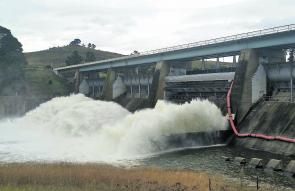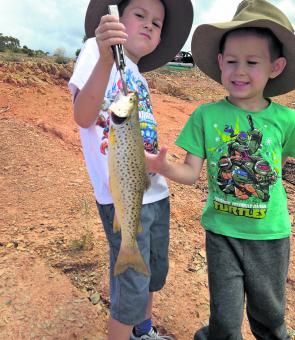Anglers are counting down the days until the start of the annual trout spawning run in the mountain streams, as the first of the twitchy browns show in the Eucumbene and Thredbo rivers.
Brown trout start their spawning or pre-spawning run in dribs and drabs in April and May, and then develop a major upstream migration during June, July and possibly August. Rainbows move later, mostly in August and September, with latecomers arriving in October.
Upstream migration is triggered largely by water flows. Given that we have just had a month's rain in 3 days, there is a strong inducement for the browns to start gathering upstream in Jindabyne and Eucumbene prior to moving into the major spawning streams, the Thredbo and Eucumbene, and a host of smaller waterways.
Anglers' catches are the best indicator of the pre-spawning movement, with uncharacteristically large fish recently coming from the Denison area, the lower reaches of the river in Eucumbene, and in the Thredbo Arm at Jindabyne. Recent catches include a nice 4.2kg fish on fly in the Eucumbene River and a swag of good browns on fly in the Thredbo. Most have been taken on large Woolly Buggers or small size 14-16 nymphs, especially those fished under a dropper on long, light leaders. Midweek fishing has been the most productive because on weekends the foot traffic puts the fish down and they stay down.
Despite the early pre-spawning movement of the browns, there is still plenty of activity in the main body of the lakes.
In Jindabyne, rainbows have dominated the fishing. They come in 2 sizes, about 30-34cm and a larger group averaging 40-45cm. They have been caught on fly, on PowerBait, and by trolling with Tasmanian Devils and small Halco, Rapala and Strike Pro minnows. A few have been taken flat lining, but some of the better catches have been with lead core line or downriggers.
Some nice browns also have been caught, especially around East Jindabyne and Kalkite. Some of the best have been taken by anglers working yabby and goldfish flies and lures along the edges of weedbeds where the fish are patrolling in search of the real thing. Steve Williamson's Goldfish fly has been particularly effective.
In Eucumbene, there have been good fish in a variety of locations. Shore-based anglers using mudeyes, scrubworms and PowerBait have done well at Yens Bay, Seven Gates and Cobrabald Bay. Trollers have found fish in deeper water and lead core line has been highly effective.
Frying Pan Arm has been especially productive. The best fish have come from the flooded bed of Frying Pan Creek, on mudeye patterns fished on sinking fly lines, and live mudeyes fished on bubble or waggler floats. Some excellent fish have also been caught on large wet flies fished behind a bubble float, which is cast out wide then retrieved slowly. This technique works surprisingly well both during the day and at night.
The ever-reliable Tantangara Reservoir has been worth a visit. The fish are mostly smallish browns, but they provide plenty of fun on lure, bait and fly. The water level has fluctuated greatly this season as stored water is bled off to top up water levels in Eucumbene and Googong. Launching a boat at locations other than the main boat ramp has been difficult in the sticky mud.
Recent rain has done wonders for the smaller trout streams in the region. Anglers who can cast accurately in tight, heavily vegetated locations have done well with dry flies such as Hairwing Coachman, Klinkhammer, Iron Blue Dun and March Brown. The browns and rainbows are mostly small, but occasionally reach 40cm and provide great fun on light #3 and #4 weight fly rods.
Rain has muddied the urban lakes and with lower temperatures and low barometric pressure, catches of golden perch, Murray cod and even redfin have declined markedly. As conditions return to normal, the fish should be hungry and come back on the bite, trying to gain condition before winter arrives.
Burrinjuck has dropped to about 30 per cent of capacity and cod and golden perch have become harder to catch. The best chance for a cod is to bounce large deep divers or spinnerbaits along the bottom in deep water. For golden perch the best locations are flooded trees, where soft plastics and other lures can be jigged up and down in about 10-12m of water.
Wyangala has been worth fishing, especially with bait from the shore around Grabine. Catches have included some smallish Murray cod, good-sized golden perch, and some nice silver perch to 42cm — mostly on scrub worms and small live yabbies.
Anglers should note that the trout season will close at midnight on Monday, June 8. The cold weather is well on the way and we have had the first significant snowfalls already. If you are planning a visit to the high country, make sure you are well prepared — warm, waterproof clothing, chains or a good 4WD, and above all make sure you have filled up with Alpine Diesel, not just regular fuel. Last year during a cold snap there were dozens of disabled 4WDs scattered all over the high country, unable to move until the whole region thawed.
Reads: 1568
Massive amounts of water were released from Lake Burley Griffin after Canberra received a month's rain in just 48 hours.

Many of the browns will move into the feeder rivers this month, beginning their pre-spawning run upstream.

Big cod in Canberra's urban lakes can be a handful for a canoe or kayak angler. It pays to gently move the fish into the shallows in order to get a decent photograph prior to release.




